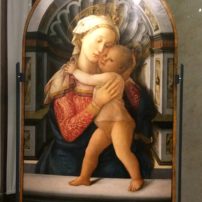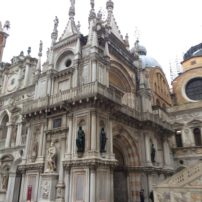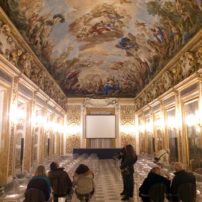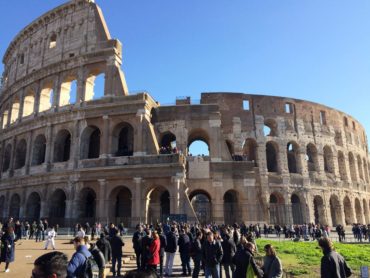
Ah, Italy! Ancient ruins, century-old churches and basilicas, wonderful restaurants and markets, picture-book scenery, canals, rolling hills, vineyards as far as the eye can see, boutique wineries and friendly people. What’s not to like?
Well, it all depends on when you go. If you choose the high season — roughly April through October — you’re likely to experience a different sort of Italy, one that is being loved to death by foreign and European visitors alike.
More than likely during those months, you will see the flip side of one of the world’s most-popular tourist destinations. Long lines for attractions, overcrowded markets and restaurants, snarling traffic, more expensive accommodations, hot and humid weather, and an increasingly creative band of pick pockets and beggars who know how to work the tourist crowd.
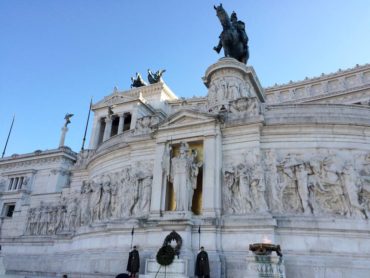
Thanks to an invitation from some longtime friends to join them on a ski trip to the Italian Dolomites last December, my wife and I quickly realized the ease and affordability of traveling to Italy in winter.
Our plans were simple. Meet our friends in the quaint little skiing village of Ortisei in mid-December, and take in the Italian trifecta of Rome, Florence and Venice beforehand.
We’re sort of do-it-yourselfers when it comes to travelling, so we made all our own hotel reservations and train connections using Italia Pass, www.ItaliaPass.com. Our hotels were comfortable and quiet, within walking distance of most attractions and surprisingly inexpensive.
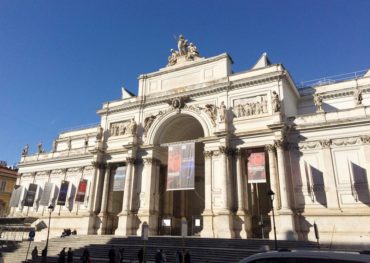
We stayed in Italy for 24 days and absorbed as much of the country’s diverse culture as possible, while also skiing down beautiful slopes and spending Christmas Eve singing “Silent Night” in front of a centuries-old chapel in a lovely mountain village.
Rome
“The Eternal City,” as Rome was called by the ancients, is spectacular and much easier to navigate than we thought.
Our first day, we toured the city’s busy streets, coming across breathtaking buildings, churches and statues, including the Altar of the Fatherland, an enormous monument to Vittorio Emanuele II, the first king of a unified Italy.
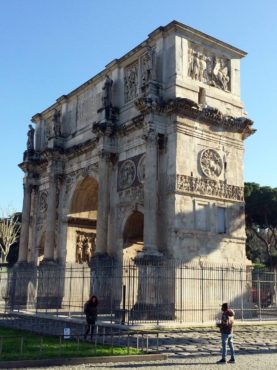
After a quick lunch in a bustling local cafe, we found Trevi Fountain, made a wish and threw pennies into the water. We then sauntered over to the uncrowded Spanish Steps and easily found the nearby Pantheon, one of Rome’s iconic ruins.
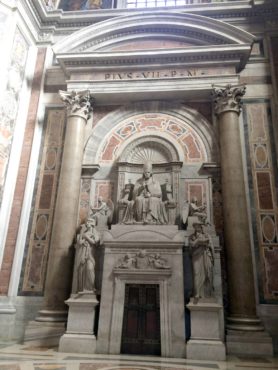
After catching up on our sleep the next day, we headed to the Colosseum. It, too, was within walking distance of our hotel. We stood in line for about 10 minutes to buy tickets before entering this massive structure that resembles a modern-day sports arena.
All sorts of events took place in the Colosseum, including slaves fighting to the death, Christians being martyred and so on, but what was really interesting to learn was how the Romans used it to develop the use of concrete, arches, columns and other architectural features that we take for granted today.
The weather was gorgeous as temperatures shot into the 60s, so we peeled off our jackets and ate a small lunch we had packed before entering the adjacent Forum. The 6-acre complex of ancient buildings, sculptures and ruins is where Julius Caesar and Cicero were assassinated, and where Ben-Hur, if there were such a person, rode his chariot on the grounds of Circus Maximus.
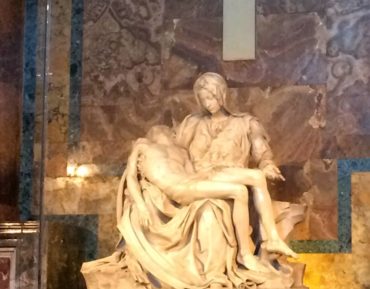
No trip to Rome is complete without a visit to Vatican City. The next day, we jumped aboard a Metro train and hopped off a few blocks from this sovereign nation within a city. The Vatican, home of the pope and seat of the Catholic Church, is walled off from the rest of Rome.
We bought our tickets, with nary a person in line ahead of us, and entered this otherworldly domain. Our goal was to see the Sistine Chapel and St. Peter’s Basilica.
The Sistine Chapel is a large space, with tall, curved ceilings in which Michelangelo painted frescos telling the story of the Old and New Testament. His most-famous paintings there are “The Creation of Adam” and “The Last Judgment.”
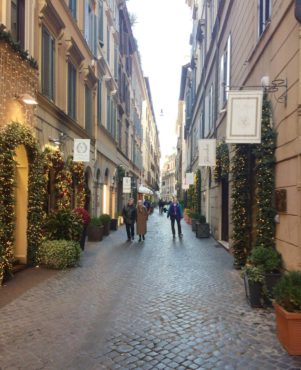
We eventually made our way to St. Peter’s, an enormous cathedral where Michelangelo’s “Pietà,” a beautiful sculpture of the Virgin Mary cradling Jesus after the crucifixion, is on display, and where the pope regularly says Mass.
Outside St. Peter’s, and still inside the Vatican grounds, is a huge plaza where you often see the pope addressing his flock on TV, and where the faithful gather to cheer the selection of a new pontiff. We took all this in while sitting on a stone bench watching kids frolicking in a nearby fountain.
Florence
As we made our way from Rome to Florence on the train the next day, the weather turned. Sunshine and blue skies gave way to gray clouds and raindrops. It felt like any winter day in the Northwest.
Florence is where the Renaissance began and the place where masters such as Michelangelo, da Vinci, Botticelli and others honed their crafts with support from the Medici family and other wealthy benefactors.
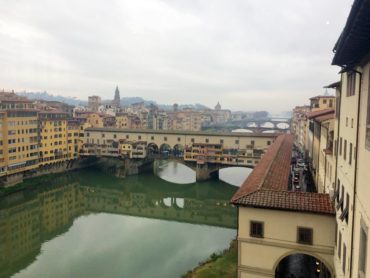
The cityscape is dominated by the Duomo, or the Cathedral of Saint Mary of the Flower. It is an architectural marvel, begun in 1296 and completed in 1436. The duomo is a complex of several buildings, including the enormous Gothic-style domed basilica — one of the biggest in Italy — and a nearby Medieval-looking tower.
As we ambled around those massive structures, we soon learned that we had arrived in Florence during the Feast of the Immaculate Conception, which is a national holiday in Italy. The streets were crammed with pilgrims visiting the city’s famous churches, bridges and landmarks.
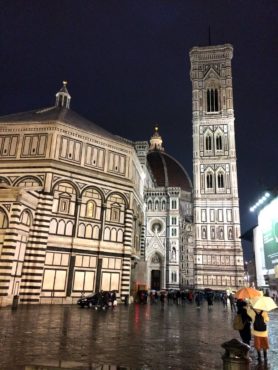
No fuss, no muss. We wandered through the crowds in the rain and, with the aid of a decent map, found the Uffizi Gallery, a huge, horseshoe-shaped, four-story building filled with incredible paintings and sculptures, including Botticelli’s “Birth of Venus” and da Vinci’s “Adoration of the Magi.”
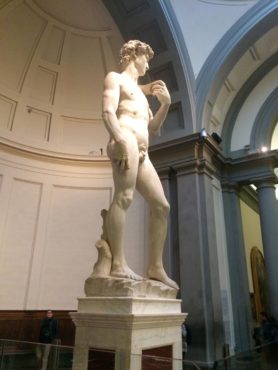
Amazingly, there were few, if any, people in line to enter this stunning gallery. We found the same situation the next morning when we walked to the Accademia Gallery, where Michelangelo’s “David” is housed.
We entered the museum, took a left, then a right, and found ourselves staring at one of the most-famous pieces of artwork created in the Renaissance, with only a handful of other tourists doing likewise.
David, the biblical character who slew the giant Goliath, is a 17-foot-tall statue that Michelangelo carved out of a single block of marble. As you admire this fabulous work from all angles — and you can do so in this exhibit — you keep wondering, how did he do it?
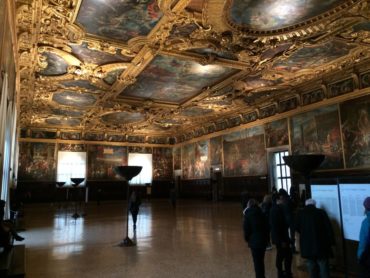
We completed our tour of Florence with a stroll over the famous Ponte Vecchio, which bridges the Arno River and connects the old city with Oltrarno, or the other side. There, you can visit Pitti Palace, walk along the ancient City Wall or amble through the Boboli Gardens, a character feature in Dan Brown’s novel, “Inferno.”
Venice
The weather improved slightly on our last day in Florence, but by the time the train arrived in “the City of Canals” the following day, it was gray, cold and drippy. Right outside the train station, we hopped aboard a vaporetto — the name of the small transit boats that navigate the Grand Canal — and sailed to our hotel.
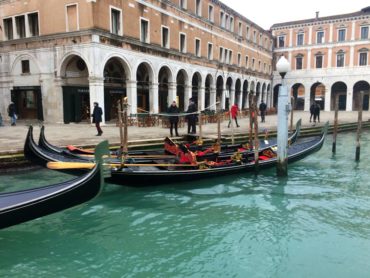
Venice is postcard-beautiful on the surface but is decaying underneath. Everywhere you look, you see old, crumbling brick, worn-out facades and fragile-looking surfaces. Restoration is happening but at a slower pace than is needed to save some of these dying structures.
Nevertheless, we were enchanted by the colors, the narrow walkways, the 400-some-odd bridges, the mammoth cathedrals, the palaces, the quaint little restaurants and shops, the nearly 200 canals, the gondolas and the simple homes of more common residents.
Because of its location on the Adriatic Sea, Venice grew up as a port city and is the home of Marco Polo, who opened up trade with the East and helped launch the legendary Silk Road.
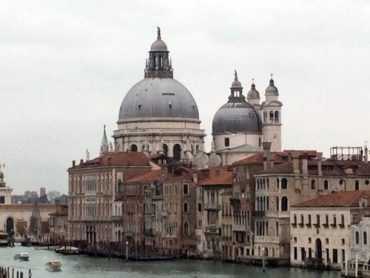
It also has ties to the Crusades, and local lore has it that early Venetians “captured” relics of St. Mark and returned them to their hometown, where a huge cathedral was built in his honor.
Today, St. Mark’s Basilica and the surrounding St. Mark’s Square is one of Venice’s main attractions. Nearby is Doge’s Palace, a multistory edifice where the doge, or duke, ruled over Medieval and Renaissance Venice.
This opulent palace is filled with unbelievable works of art, statuary, enormous rooms and even a prison. The doges were supposed to be democratic but all evidence points to a more dictatorial style.
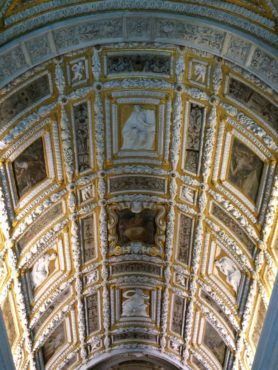
As in the other places we visited, we soon discovered that the best way to see Venice was on foot. It allowed us to find the University District, an out-of-the-way coffee shop (where no one spoke English), the Guggenheim Museum and the Frari Church.
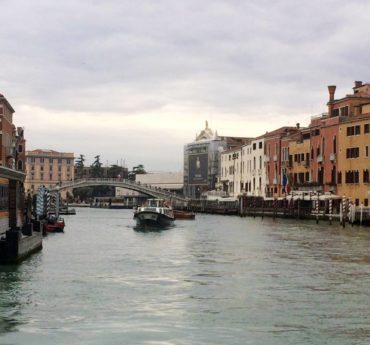
The latter structure, tucked away in an older residential neighborhood, was almost empty when we arrived in midafternoon, and much to our astonishment, displayed works by Botticelli, Donatello, Michelangelo and other masters. It was a truly amazing find.
As we made our way by train to Bolzano to the north and then by bus to Ortisei for the skiing leg of our trip, we realized just how lucky we were to be visiting Italy in the dead of winter.
If you don’t mind some cold weather, and maybe a little rain, it’s a no brainer!




